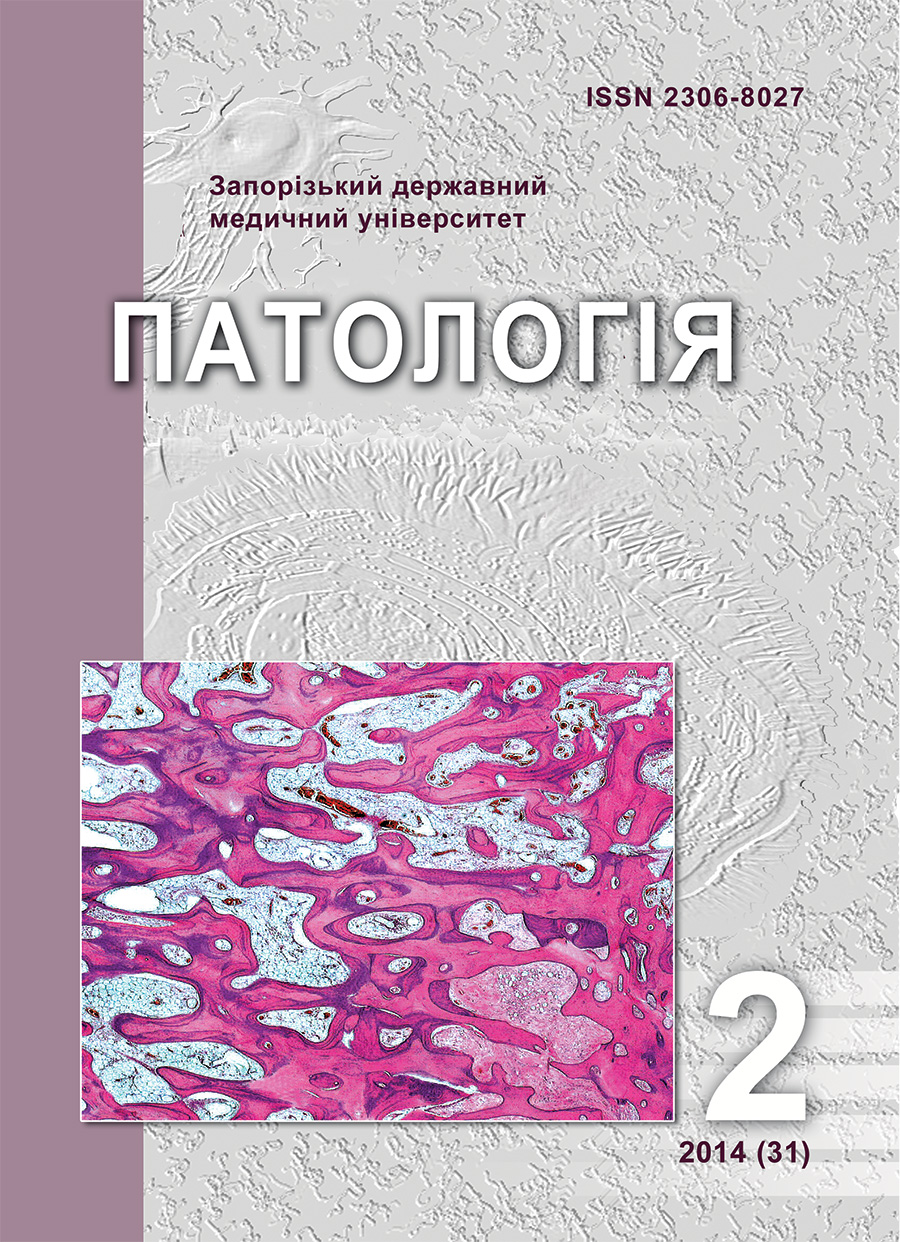Determination of muscle differentiation markers SMA and MSA in CD117-positive and CD117-negative gastrointestinal stromal tumors of different malignant potential
DOI:
https://doi.org/10.14739/2310-1237.2014.2.28561Keywords:
Gastrointestinal Stromal Tumors, MSA, SMA, NeoplasmsAbstract
Aim. To determinate the muscle differentiation markers SMA and MSA in CD117-positive and CD117-negative gastrointestinal stromal tumors of different malignant potential.
Mеthods and results. Gastrointestinal stromal tumors (GIST) require a thorough differential diagnosis with smooth muscle tumors (benign and malignant) of the gastrointestinal tract. In order to determine the relationships between the clinical (age, localization of the primary tumor) and morphological (histological type of structure, expression of markers of histogenesis - CD117 and proliferative activity - Ki-67) characteristics of GIST and expression of markers of muscle differentiation we studied character of coloring SMA, MSA in the 47 cases (immunohistochemical method).
Сonclusion. It was established, that MSA-positive GIST were found in 6.4%. Distribution of SMA-positive cases in groups with different clinical and morphological characteristics is similar. In our study, we found no prognostic value of the marker SMA, although samples with high levels of expression of marker Ki-67 are more common among SMA-positive cases (p> 0.05).
References
Miettinen, M., & Lasota, J. (2011). Histopathology of gastrointestinal stromal tumor. Journal of surgical oncology, 104(8), 865–873. doi: 10.1002/jso.21945.
Selcukbiricik, F., Yalçın, S., Tural, D., Erdamar, S., Demir, G., Doğusoy, G., & Mandel, N. M. (2012). Gastrointestinal stromal tumors in Turkey: experiences from
Hamilton, S.R., Aaltonen, L.A. (2000). World Health Organisation classificatoin of tumors. Pathology and genetics of tumors of the digestive system. Lyon: IARC Press.
Demetri, G. D., Benjamin, R. S., Blanke, C. D., Blay, J. Y., Casali, P., Choi, H. & Zalcberg, J. (2007). NCCN Task Force report: management of patients with gastrointestinal stromal tumor (GIST)-update of the NCCN clinical practice guidelines. Journal of the National Comprehensive Cancer Network: JNCCN, 5, 1–29.
Joensuu, H., Hohenberger, P., & Corless, C. L. (2013). Gastrointestinal stromal tumour. The Lancet, 382(9896), 973–983. doi: 10.1016/S0140-6736(13)60106-3.
Odze, R. D., Goldblum, J. R., & Crawford, J. M. (2004). Surgical pathology of GI tract, liver, biliary tract, and pancreas. New York.
Belev, B., Brčić, I., Prejac, J., Golubić, Z. A., Vrbanec, D., Božikov, J., & Razumović, J. J. (2013). Role of Ki-67 as a prognostic factor in gastrointestinal stromal tumors. World journal of gastroenterology: WJG, 19(4), 523. doi: 10.3748/wjg.v19.i4.523.
Fletcher, C. D., Berman, J. J., Corless, C., Gorstein, F., Lasota, J., Longley, B. J. & Weiss, S. W. (2002). Diagnosis of gastrointestinal stromal tumors: a consensus approach. International Journal of Surgical Pathology, 10(2), 81–89. doi: 10.1177/106689690201000201.
Kornilova, A. G., Kogoniya, L. M., Mazurin, V. S., Bordanov, S. V. & Okseniuk, O. S. (2014). Gastrointestinal'nye stromal'nye opukholi: sovremennaya klassifikaciya, differencial'naya diagnostika i faktory prognoza. E`ffectyvna farmakoterapiya, 14(1), 20–23. [in Russian].
Downloads
How to Cite
Issue
Section
License
Authors who publish with this journal agree to the following terms:- Authors retain copyright and grant the journal right of first publication with the work simultaneously licensed under a Creative Commons Attribution License that allows others to share the work with an acknowledgement of the work's authorship and initial publication in this journal.

- Authors are able to enter into separate, additional contractual arrangements for the non-exclusive distribution of the journal's published version of the work (e.g., post it to an institutional repository or publish it in a book), with an acknowledgement of its initial publication in this journal.
- Authors are permitted and encouraged to post their work online (e.g., in institutional repositories or on their website) prior to and during the submission process, as it can lead to productive exchanges, as well as earlier and greater citation of published work (SeeThe Effect of Open Access).

